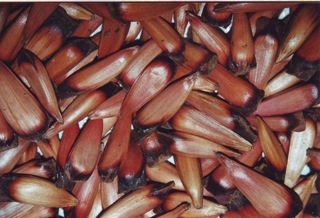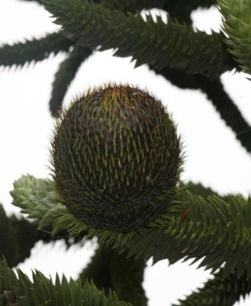Lunch Drops In
My good friend Saul is a luthier, a man who works with exotic woods. He repairs premium wooden instruments. It is not unusual for him to be working on a Stradivarius or a Guarneri someone sat on. And for 30 years he thought the tree right outside his shop was a Monkey Puzzle Tree, Araucaria araucana (air-ah-KAIR-ee-uh air-ah-KAY-nuh.) That’s what it was sold as. It’s not. It’s a close relative, the Bunya Pine. The falling cones from either, however, can still injure you.
The Monkey Puzzle Tree is from Central Chile and Argentina. But, it’s a common landscape plant in Florida and southern border states all the way to California then up the west coast. It is also cultivated in England and Ireland, In fact the tree’s name came from an incident in England’s Cornwall in 1850. The tree back then was rare in gardens and not widely known. The owner of a young tree at Pencarrow Garden was showing it off to a group of friends when one said “It would puzzle a monkey to climb that.” At the time the tree had no common name in English. It was first called the ‘monkey-puzzler’ tree but ‘monkey-puzzle tree’ eventually caught on.
The point has been made that any monkey trying to climb the tree would likely be injured. Its leaves are more like ferocious reptilian spines than leaves. And, monkeys don’t live in the tree’s native range. However, dinosaurs did some 250 million years ago and there is some speculation that the ancient tree’s armament was to dissuade dinosaurs from lunch. Most surprisingly, it’s in the Pine family closely related to the Norfolk Pine, Araucarua excelsa (air-ah-KAIR-ee-uh eck-SELL-suh.) Like the Natal Plum and Chinese Elm, it’s an easy-to-find tree in temperate suburbia. They’ll be around for a while because some are at least 2,000 years old or more.
While found mostly among southern border states the tree is actually hardy and prefers cooler climates with some nice specimens in the Pacific Northwest states and British Columbia. It is a favorite display tree in Great Britain and grows well in Australia and New Zealand. It does, however, take a male and a female tree to produce cones and seeds, usually a ratio of seven ladies to one fellow but I’d plant two guys just in case. The delicious seeds are edible raw or cooked. They are rich in starch and resemble an almond in size with a slight flavor of pine nuts.
The official tree of Chile, it was first found by outsiders the 1780s. It was named Pinus araucana 1782. By 1873, after a lot of botanical arguments, it became Araucaria araucana. The name Araucana comes from the native Araucano People who used the seeds of the tree in Chile. Sadly its numbers are dropping in its native range and has been protected since 1990.
Lastly, the seeds of the Araucaria bidwillii, (air-ah-KAIR-ee-uh bid-WILL-ee-eye) a native of Australia, are also edible.
Green Deane’s “Itemized” Plant Profile
IDENTIFICATION: Pyramid-shaped tree 90 to 130 feet tall, 3 to 4 feet in diameter. The branches grow horizontally in whorls of five in opposite pairs, drooping, stems brittle, bark corky; feathery leaves, pale green, compound, tripinnate; The leaf is an armor-like scale, triangular, oval to lance shape, 1 to 2 inches long, shiny green on both surfaces but surface marked with longitudinal lines, RAZOR SHARP. Male and female flowers. Male cones and female cones. Female cones are large, round, dark brown, develop in two to three years, 4 to 7 inches long, 3 to 6 inches wide, falloff at maturity; split in three when dried, 200 seeds are brown to orange, triangular in shape with papery wings, 1 to 1 1/2 inches long, the nut is long and narrow with 2 small even wings that are denticulate at the top.
TIME OF YEAR: When ever you find thefemale cones on the ground.
ENVIRONMENT: Prefers well-drained, slightly acidic, volcanic soil but will tolerate almost any soil type. It produces the heaviest where there are cool summers.
METHOD OF PREPARATION: Seeds, raw or cooked. They can be boiled or roasted. Ground, they make a good flour substitute.
HERB BLURB
Resin from the tree is used to treat wounds and ulcers.




Are norfolk pines edible? I have one in my front yard dripping sap. Is it possible to use the seeds or sap for anything?
Not that I know of.
Article says “Resin from the tree is used to treat wounds and ulcers.”
Do you know where we can see a monkey puzzle near central florida? My son is a budding 9 yr old paleo-botanist (is that a word?) and is dying to see one. The closest I have come is the bunya bunya.
The entrance to Mead Garden, Winter Park, direcly on your left.
I live in Ocala Florida and would like to grow a monkey puzzle tree they are awesome will they survive here and can you recommend a reputable grower
I will need to cut down a 40′ to 50′ monkey puzzle tree from a property in Largo, FL that I recently purchased. I worry about the liability of those huge seeds dropping on someone’s head who is walking by. Or, dropping on and damaging someone’s vehicle. Is there anyone out there who is interested in the wood?
Hi i have a Monkey puzzle tree in my yard to which we had to cut down. Iv donated all the trunk to local wood crafters but have kept all the brown seeds to which fell off, i’v also kept all the big round cones that were on it. I’m wondering if i crack the Cones open are there nuts inside to which are edible?? As i’v been told by a friend and i’m un-sure. I would like to “recycle” if that’s the correct term as much as possible as my tree was some 24/25 years old and rather dear to us.The ‘cones’ never fell off the tree i cut them off at the butt and saved them. Any advice and wisdom would be very appreciated.
Thank you for your time.
Amanda 🙂
They are edible when they fall. Before that it is iffy. Personally, I would taste one, carefully.
Amanda, I am so glad you are alive and well if you used to have an Araucaria Bidwillii tree…. https://sydneylivingmuseums.com.au/plant-your-history/look-out-below-bunyas-above (for you to see its size!!)
One fruit(?) from that tree almost killed me some years ago. And … my neighbors continue sitting under that tree!?
Hi,
We were offered branches of the Monkey puzzle tree for fire wood
1.) Does the wood give off toxic fumes when burning?
2.) Can we prepare meat over the coals; do the coals give off toxic fumes?
Regards
Cheryl
I don’t know. A close relative, the Bunya Pine, is esteemed for its smoke.
I have a monkey tree that is now about 40 yrs old. It has always been a male tree with the male cones. Approximately 18-24months ago it started growing four female cones at the very top and they are now throwing the seeds out. You say that there must be male and female trees for them to seed. Mine is the only one for some miles so is this unusual to have both male and female cones? They also throw the seeds not just drop them and when the cone first opens to throw the seeds the first time it makes a noise is this also unusual?
Call a local state college or university and ask for recommendations to an ethnobotanist…where is this tree?
Will The Monkey Puzzle Tree grow In Fotr Worth, Texas Very Hot Weather.
Yes, it’s more cold weather that’s a problem than hot weather.
I would like to purchase some monkey puzzle tree seeds directly from Argentina or Chile. Does anyone know who I should contact in Argentina or Chile to buy the seeds directly from them?
Thanks.
John
My neighbor has one. Haven,t seen cones yet, but boy she hates that tree. Had flip-flop failure. Ouch!!!
i HAVE LOT OF RESIN OF MONKEY PUZZLE TREE IS ITS USEFULL
To Israr,,, please send it my way. Thank you! ?
I just learned today that Araucara araucana is prohibited in Arizona. Can you tell me why?
I grew up with a “false monkey puzzle” tree in our backyard. It was planted around 1930 and was measured at 170 feet tall. It’s base is over 6ft thick.
Every four to eight years, it will drop 70-100 seed pods, which contain 72 to 75 seeds.
We would collect them before the squirrels would eat them, dry them, drill holes in them, then roast them.
We would make a mixture of different flavors, inject them in to the hole before roasting.
They are by far the best nuts I’ve eaten. Larger and reminding me more of a bread fruit because they are high in water.
It was about the millennium a lady at work was going to get rid of a wee tree that was growing and had broken the pot, I put my hand up to take it off her hands, it was a Monkey Puzzle tree, my wife & I placed it in the paddock about 30metres away from the house. Today it’s approx. twice the height of the house, we’ve circled it (about 5m diameter), weed matted and placed white sea shell around it, over those growing years we cut off the lower branches for safety reasons and on one occasion the lower branches were going brown so I dosed it with copper and lavished it with seaweed liquid feed. It has round nuts forming, not dropped off yet. The fact we have nuts forming does this mean it may have been a grafted specimen?
In my experience only unpollinated cones drop (maybe 5 per 1000). The pollinated cones mature on the tree. They explode (very audibly) on hot summer days. The clock is followed by a loud flickering noise as the seeds tumble through the branches and disperse over a wide area.
There’s never a viable seed in a cone that falls to the ground